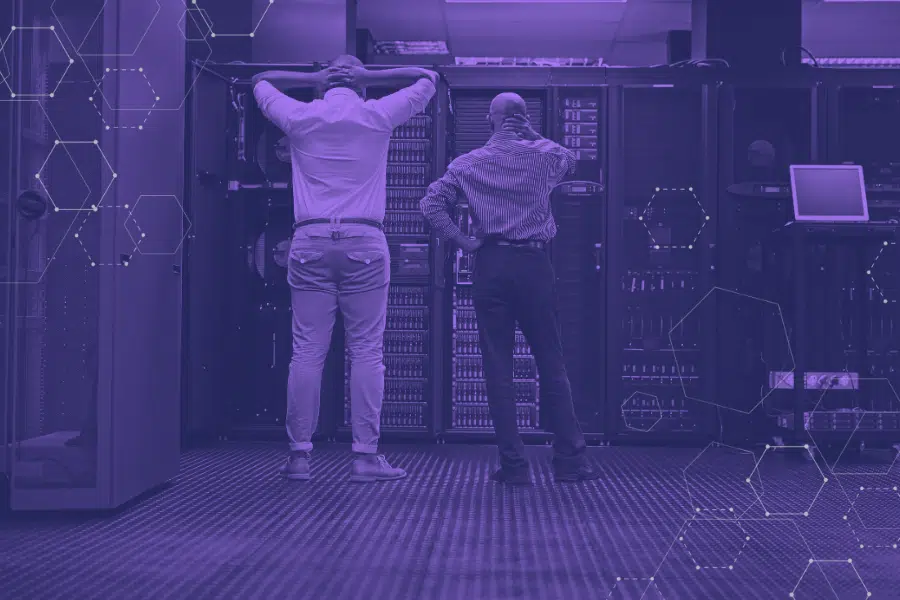In the world of IT and cybersecurity, complexity has long been the norm, particularly when it comes to setting up and managing networks. Traditionally, companies began their IT journey by establishing a physical office, purchasing internet services, and installing a firewall.
Behind this firewall, they would build a Local Area Network (LAN), often centered around a domain controller with an on-premises identity provider. This approach served businesses well for years, but the landscape has dramatically shifted since 2020.
Today, small and medium-sized businesses are increasingly moving away from these legacy solutions, driven by the rise of cloud-based identity providers like Google Workspace and Microsoft 365. Despite the clear advantages of modern, cloud-first solutions, many companies continue to cling to their outdated systems, facing significant costs and inefficiencies as a result.
This article explores the transition from complex, legacy IT networks to more streamlined, cloud-based alternatives, and why abandoning complexity is the key to futureproofing your business.

The Legacy IT Network
In the early stages of building their IT infrastructure, most companies followed a well-trodden path. The journey began with securing a physical office space and then investing in internet services. To protect this connection and the company’s digital assets, a firewall was installed—a critical component in safeguarding against external threats.
Behind this firewall, the next step was to establish a Local Area Network (LAN). This network connected all the company’s computers and devices, enabling internal communication and resource sharing. At the heart of this LAN was the domain controller, a powerful server responsible for managing network security and permissions. The domain controller also hosted the company’s identity provider, which was typically housed on-premises. This setup centralized control over user access, ensuring that only authorized individuals could log into the network and access sensitive information.
For years, this model was the gold standard for businesses, offering a sense of security and control. However, it also came with significant complexities, from the initial setup to ongoing maintenance.
Companies were tied to their physical infrastructure, relying on hardware that required constant updates and monitoring. As technology advanced and business needs evolved, the limitations of this legacy approach became increasingly apparent.
Central to the traditional IT setup was the on-premises identity provider. This system played a crucial role in managing user identities, controlling access to the network, and ensuring that only authorized personnel could reach critical resources. Typically, the identity provider was hosted on the company’s domain controller—a server that was physically located within the office, making it a cornerstone of the organization’s security framework.
On-premises identity providers offered a sense of control and security, as everything was managed internally. IT teams could closely monitor who had access to what, set strict policies, and ensure that sensitive information remained behind the firewall. However, this approach also brought with it a range of challenges.
Managing an on-premises identity provider required significant resources, both in terms of hardware and personnel. Servers needed to be regularly maintained, updated, and secured against potential threats. Any downtime or hardware failure could lead to significant disruptions, affecting the entire business. Furthermore, as companies grew and expanded, the complexity of managing user identities increased, often necessitating additional infrastructure and specialized IT expertise.
In today’s rapidly changing technological landscape, the limitations of on-premises identity providers have become increasingly apparent. The need for flexibility, scalability, and ease of integration with cloud-based services has driven many businesses to seek alternatives.
As we’ll explore, the rise of cloud-based identity providers like Google Workspace and Microsoft 365 offers a solution that not only simplifies management but also enhances security and accessibility.

The Shift in 2020
The year 2020 marked a pivotal moment in the world of IT and business operations. The global pandemic forced organizations of all sizes to rapidly adapt to remote work, accelerating a shift that had been gradually unfolding for years. As offices closed and employees began working from home, the limitations of traditional, on-premises IT infrastructure became painfully clear.
Companies that had relied on physical networks and on-premises identity providers suddenly found themselves struggling to provide secure access to their remote workforce. The once-reliable LAN was no longer sufficient, as employees needed to connect from various locations, often using personal devices. The demand for scalable, flexible, and easily accessible IT solutions skyrocketed, and with it, the adoption of cloud-based services.
Two major players emerged as the go-to identity providers for small and medium-sized businesses: Google Workspace and Microsoft 365. These cloud-based platforms offered a stark contrast to the legacy systems that many companies had depended on. With Google Workspace and Microsoft 365, businesses could manage user identities and access securely in the cloud, without the need for on-premises hardware or complex VPN configurations.
The shift to these cloud-based solutions wasn’t just about convenience—it was about survival. Companies that embraced these platforms were able to maintain productivity, ensure security, and continue operations despite the disruptions caused by the pandemic.
For those still clinging to legacy systems, however, the challenges were daunting. The pandemic exposed the weaknesses of on-premises identity providers and underscored the urgent need for a more modern, agile approach to IT.

Challenges of Sticking with Legacy Solutions
For businesses that have chosen to hold onto their legacy IT infrastructure, the challenges are becoming increasingly difficult to ignore. Sticking with traditional, on-premises solutions might feel familiar and secure, but in today’s fast-paced, cloud-driven world, this approach can quickly become a costly burden.
One of the most significant challenges is the ongoing expense of maintaining outdated systems. Legacy solutions require continuous investment in hardware, software licenses, and specialized IT staff to keep everything running smoothly. These costs can add up quickly, draining resources that could be better spent on innovation and growth. Moreover, as manufacturers phase out support for older technologies, companies may find themselves locked into expensive contracts for appliances that are no longer being actively developed or improved.
Beyond the financial burden, there’s the issue of cloud integration. As more business operations move to the cloud, companies with legacy networks often struggle to bolt on these new technologies to their existing on-premises systems. This patchwork approach can lead to inefficiencies, security vulnerabilities, and a lack of cohesion between various IT components. Instead of benefiting from the seamless integration that cloud-first solutions offer, businesses are left with complex, cumbersome systems that require constant attention and troubleshooting.
Additionally, sticking with legacy solutions can result in a significant time investment. IT teams must dedicate hours to maintaining, updating, and securing on-premises systems, often at the expense of more strategic initiatives.
As the workforce becomes increasingly mobile and remote, the limitations of traditional networks—such as the need for robust VPN connections and high-speed internet to support full-tunnel access—can further complicate matters, leading to frustrating delays and bottlenecks.
Ultimately, the companies that continue to rely on legacy IT solutions find themselves trapped in a cycle of rising costs, growing inefficiencies, and increasing risk. As technology continues to evolve, the gap between legacy systems and modern solutions will only widen, making it even more challenging for these businesses to keep up with the demands of a digital-first world.

The Modern Alternative
In response to the challenges posed by legacy IT systems, many businesses are turning to modern, cloud-based alternatives that offer simplicity, flexibility, and enhanced security. These solutions, led by platforms like Google Workspace and Microsoft 365, represent a paradigm shift in how companies manage their IT infrastructure and operations.
One of the most significant advantages of these modern alternatives is their ability to simplify network management. By moving identity providers and other critical services to the cloud, businesses can eliminate the need for expensive on-premises hardware and reduce the complexity of their IT environment. This not only cuts costs but also frees up IT teams to focus on more strategic tasks, rather than spending time maintaining outdated systems.
Cloud-based solutions also offer unparalleled scalability. As a business grows, its IT needs can expand seamlessly without the need for significant additional investments in physical infrastructure. Whether it’s adding new users, deploying new applications, or scaling storage and computing resources, these platforms can accommodate changes with just a few clicks. This flexibility is especially crucial in today’s fast-paced business environment, where the ability to quickly adapt to new challenges and opportunities can be a competitive advantage.
Security is another critical area where modern alternatives outshine legacy systems. With cloud-based identity providers, businesses can take advantage of advanced security features like multi-factor authentication, automated threat detection, and continuous monitoring. These tools are designed to protect against the latest cyber threats, providing a level of security that is often beyond the reach of traditional on-premises solutions. Moreover, because these platforms are managed by leading technology companies, businesses can rely on them to stay up to date with the latest security patches and best practices.
In addition to security and scalability, the user experience is significantly improved with modern solutions. Employees can access the resources they need from anywhere, on any device, without the need for cumbersome VPNs or complex login procedures. This ease of access not only boosts productivity but also supports a more flexible, remote-friendly work environment—a key consideration in the post-2020 world.
In summary, modern alternatives to legacy IT systems provide a compelling case for businesses to embrace change. By moving to cloud-based solutions, companies can reduce costs, enhance security, improve scalability, and create a more user-friendly environment. In a world where agility and efficiency are increasingly important, abandoning the complexity of legacy systems in favor of modern alternatives is not just a smart choice—it’s a necessary one.

Leading the Way in Cloud-First IT & Cybersecurity
The days of complex, on-premises IT systems are numbered. As the business landscape continues to evolve, clinging to legacy solutions is becoming an increasingly untenable strategy. The shift toward cloud-based platforms like Google Workspace and Microsoft 365 isn’t just a trend—it’s a necessary adaptation to the realities of modern business operations.
By embracing these modern alternatives, companies can shed the heavy burdens of maintaining outdated hardware, navigating complex licensing structures, and struggling to integrate with new technologies. Instead, they can unlock a world of simplicity, scalability, and security that empowers their workforce and streamlines operations.
The message is clear: the future belongs to those who are willing to abandon complexity in favor of a more agile, efficient, and secure IT environment. The time to make that transition is now, before the growing gap between legacy systems and modern solutions becomes too wide to bridge.
For businesses ready to take the leap, the rewards—both in terms of cost savings and operational excellence—are well worth the effort.





